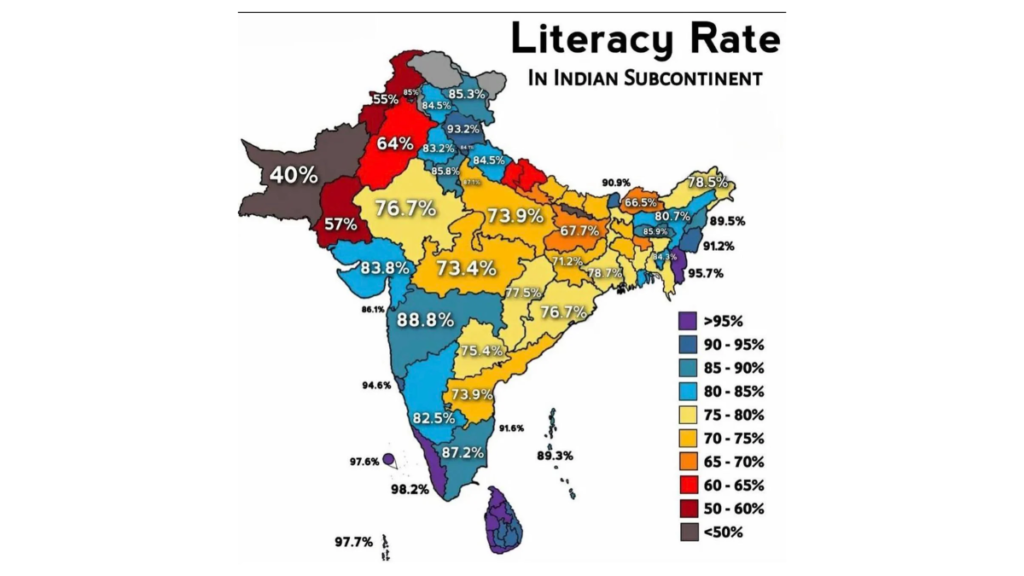India’s 80.9% Literacy Rate Doesn’t Tell the Whole Story?
At first glance, India’s literacy numbers sound like a success worth celebrating. With over 80% of people aged seven and above now considered literate, the country appears to be moving forward. But when you look a little closer, the picture gets more complicated. Behind that single percentage lies a web of inequalities—between men and women, cities and villages, the privileged and the forgotten.
The Story Behind the Statistics
The Periodic Labour Force Survey (PLFS) 2023–24, conducted by the National Sample Survey Office, reveals some striking contrasts. On one hand, places like Mizoram (98.2%), Lakshadweep (97.3%), and Kerala (95.3%) have shown what’s possible when government support, access to schools, and social reforms come together. But in many other parts of the country, especially rural and poorer regions, the education system is still failing millions.
The Hidden Gap: Literacy Is Not Equal
We often hear that four out of five Indians are now literate. But what does that really mean when women and girls are still so far behind? For every 100 literate men in India, there are only about 87 literate women. In rural areas, the gap is even worse. Take rural Rajasthan, where 83.6% of men can read and write—but only 61.8% of women can. That’s a 22-point gap, and it tells a painful story of traditions, barriers, and opportunities denied.
*→ This highlights the core issue of India literacy rate gender and regional disparity.
Rural vs. Urban: A Divide That Runs Deep
The difference between rural and urban India isn’t just geography—it’s about access, opportunity, and broken systems. Urban literacy is close to 89%, while in rural India it’s 77.5%. In Madhya Pradesh, the divide is more than 14 percentage points. In Bihar, rural schools continue to suffer from poor infrastructure, a lack of trained teachers, and minimal investment in girls’ education. For too many children in villages, going to school still feels like a privilege—not a right.
→ Another layer of the India literacy rate gender and regional disparity is revealed through rural-urban comparisons.
Why Girls Still Fall Behind
In some parts of the country—like Rajasthan, Bihar, and Madhya Pradesh—cultural traditions still dictate that girls marry early or stop studying after puberty. Education becomes optional for them, even though it should be a guarantee. These are not isolated stories; they reflect deeply rooted systems that continue to hold girls back. And no amount of policy change will help unless these social norms are also challenged.
→ Gender norms add to the persistent India literacy rate gender and regional disparity.
Success in Some States Isn’t Enough
When Mizoram can reach a female literacy rate of 97%, while rural Madhya Pradesh struggles at 62.6%, it shows the kind of inequality that India must urgently address. Kerala’s success didn’t happen overnight—it came from decades of public investment, reform, and valuing education for all. But that model hasn’t been replicated in many other regions. Poverty, politics, and patriarchy still stand in the way.
→ These contrasting performances underscore the India literacy rate gender and regional disparity.

What Counts as Literacy?
According to official definitions, being literate means being able to read and write with understanding in any language. But with such a low bar, what are we really measuring? Can we truly say we’re educating a nation when millions of people still can’t access books, quality teaching, or even a functional school?
It’s Time to Go Beyond the Numbers
India is at a crossroads. Boosting literacy numbers isn’t enough anymore. The next step is harder, but more important: ensuring that every child—especially every girl in every remote village—can go to school, stay there, and learn in a safe, supportive environment. That means listening to the unheard voices: the girls forced to drop out, the rural students without a classroom, the communities left behind by the system.
→ Bridging the India literacy rate gender and regional disparity will require systemic reforms.
Education as a Tool for Freedom
Literacy should mean more than being able to read. It should mean confidence, independence, and the ability to dream beyond one’s circumstances. The fact that, in 2025, India still sees girls leaving school too early and rural schools struggling to function is not just unfortunate—it’s a moral failure.
True progress won’t be achieved until every child can learn freely, without fear or restriction. Because education is not a favor or a luxury. It’s a right. The foundation for every other right we hold dear.
Also Read: Kerala Plus One Result 2025 Declared – Step-by-Step Check Guide
Also Read: Trump Education Secretary Gets Embarrassing Math Lesson in Hearing